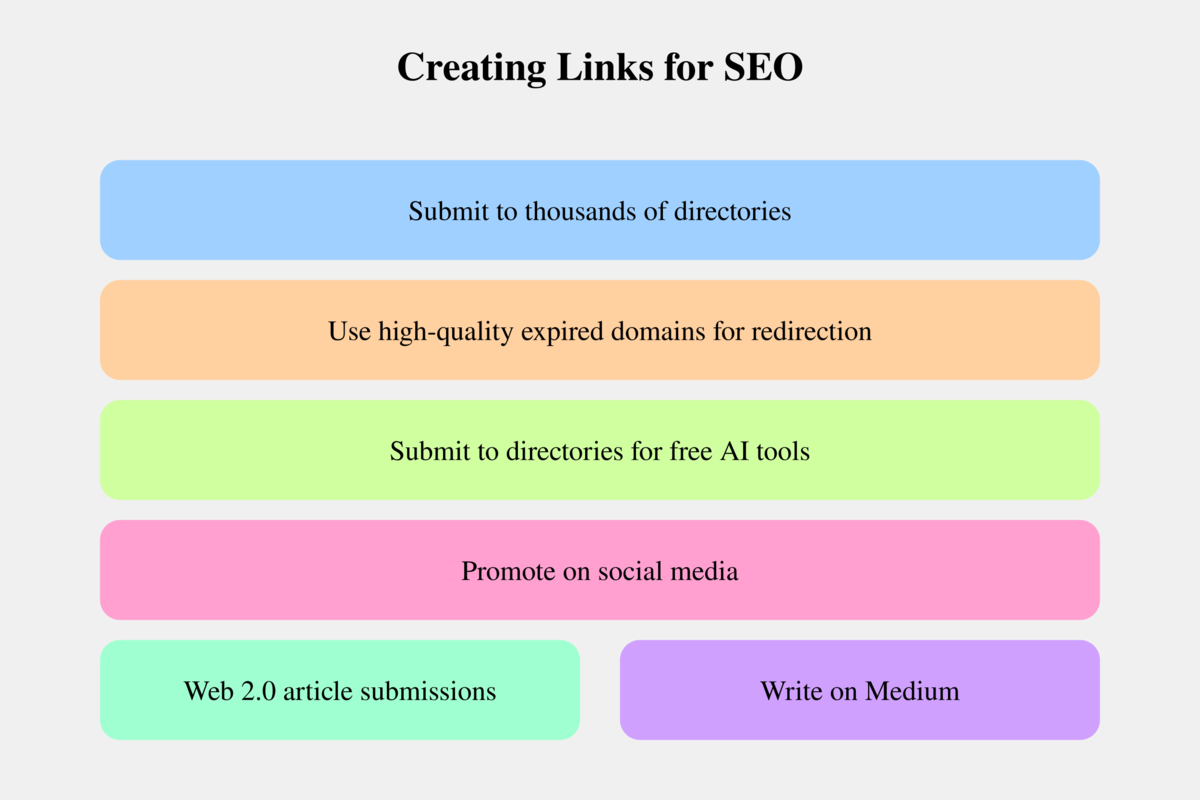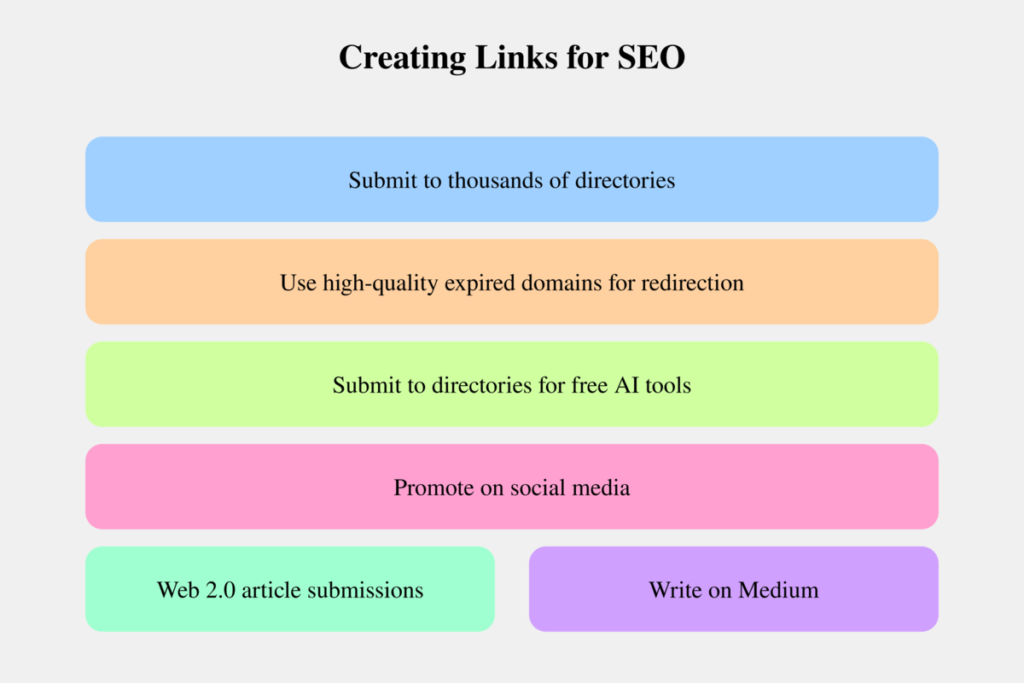Table of Contents
- Introduction
- What is building links in SEO?
- What is linking structure in SEO?
- What are the different types of links in SEO?
- How do I create a link for SEO?
- How does link building impact search engine rankings?
- What are the benefits of link building for SEO?
- What are the best practices for link building?
- What are the common mistakes to avoid in link building?
- What are the most effective strategies for acquiring backlinks?
- What are the differences between white hat and black hat link building techniques?
- What tools can be used to aid in link building?
- How can ClimbContent help you in link Building in SEO?
- Summary
Introduction
Mastering SEO link building strategies is essential for building a strong online presence. Whether you\’re new to digital marketing or a seasoned pro, understanding how to acquire high-quality backlinks can elevate your website\’s search engine rankings. In this comprehensive guide, we\’ll explore the essentials of SEO link building, different types of SEO links, and best practices to ensure your efforts yield maximum results. So, let\’s dive into strategies that can boost your website\’s visibility and drive organic traffic.
What is building links in SEO?
SEO link building is the process of acquiring hyperlinks from other websites to your own, and these links, also known as backlinks, play a crucial role in search engine rankings. Search engines like Google use these links to crawl the web and rank web pages. High-quality backlinks can improve your website’s visibility and credibility. This practice involves various strategies such as guest blogging, directory submissions, and social media engagement. It is important to focus on acquiring links from reputable and relevant websites. Poor-quality or spammy links can harm your rankings, and maintaining a natural link profile is essential. Overdoing link-building can lead to penalties from search engines. Therefore, a balanced and ethical approach is always recommended.
What is linking structure in SEO?
Linking structure in SEO refers to how the various pages on a website are connected through hyperlinks. It plays a crucial role in helping search engines understand the hierarchy and relationship between different pages. Good internal linking ensures that important pages are easily accessible to both users and search engine crawlers. It also helps distribute page authority and ranking power across the site. A well-organized linking structure can improve the overall user experience. Websites with effective internal links often see better SEO performance. Therefore, it’s essential to plan and manage linking structure carefully to maximize its benefits.
What are the different types of links in SEO?
In SEO, there are several types of links that play crucial roles. Internal links connect different pages within the same website, helping users and search engines navigate the site. External links, or outbound links, direct users from your site to other websites, adding value and credibility to your content. Backlinks, also known as inbound links, are links from other sites pointing to your website; they significantly impact your site’s authority and ranking. Nofollow links tell search engines not to pass any link equity, influencing a site’s ranking. Dofollow links, on the other hand, allow search engines to count them as votes of quality, boosting SEO. There are also anchor text links, which use clickable text to guide users and search engines.
How do I create a link for SEO?
Creating a link for SEO involves several strategic steps. First, use descriptive anchor text that accurately reflects your content. Include relevant keywords within the anchor text for better visibility. Avoid using generic phrases like “click here.” Make sure the URL is clean and contains keywords. Always link to high-quality, authoritative sites. It’s important to have a mix of internal and external links. Keep the link placement natural within the content. Regularly update and check links to avoid broken paths. By following these steps, you can improve your site’s SEO performance.
To create backlinks, I submit my site to thousands of directories.
I use high-quality expired domains with existing backlinks to redirect to my site.
Directories for submitting free AI tools.
General promotions in social media
Web 2.0 article submissions
Writing on Medium has been an excellent source of traffic for me.
How does link building impact search engine rankings?
Link building significantly impacts search engine rankings by enhancing a website’s authority and credibility. When reputable websites link to your content, search engines perceive it as a vote of confidence. These backlinks serve as endorsements that signal to search engines that your site is valuable and trustworthy. Consequently, your website may rank higher in search results. Quality is crucial; links from spammy or irrelevant sites can harm your rankings. Additionally, a diverse backlink profile with links from varied domains is beneficial. Effective link building can improve organic traffic and overall SEO performance.
What are the benefits of link building for SEO?
Link building is a crucial aspect of SEO that offers several key benefits. It helps improve website authority, making it more credible in the eyes of search engines. This, in turn, can lead to higher rankings in search engine results pages (SERPs). Additionally, quality backlinks drive more organic traffic to your site, increasing visibility and potential customer engagement. Effective link building also helps search engines discover and index new pages on your website. It provides more opportunities for referral traffic, further broadening your audience. Over time, these advantages contribute to a stronger online presence and better overall performance.
What are the best practices for link building?
Link building is essential for improving your website’s search engine rankings. One of the best practices is to create high-quality, valuable content that others naturally want to link to. Guest blogging on reputable sites can also help you gain quality backlinks. Focusing on building relationships with industry influencers and bloggers can increase your chances of earning links. Broken link building is another effective strategy, where you identify broken links on other websites and offer your content as a replacement. Additionally, ensuring your own site is backlink-worthy with a strong internal linking structure is important. Always monitor your backlinks to avoid low-quality or spammy links that could harm your ranking.
What are the common mistakes to avoid in link building?
In link building, one common mistake is focusing on quantity over quality. It’s important to avoid low-quality or spammy links, as these can harm your site’s reputation and rankings. Another mistake is neglecting relevance; links should come from sites within your industry or niche. Ignoring anchor text diversity can also be detrimental, as repetitive or unnatural anchor texts can trigger search engine penalties. Additionally, failing to track and adjust your strategy can lead to missed opportunities and ineffective campaigns. Lastly, not building relationships with reputable sites can limit your link-building potential. Ensure your efforts are consistent, strategic, and focused on high-quality links.
What are the most effective strategies for acquiring backlinks?
Acquiring backlinks effectively involves several key strategies. First, create high-quality, shareable content that naturally attracts links from other websites. Guest posting on reputable blogs within your niche can also help. Engage in outreach by contacting industry influencers and offering valuable insights or content. Use broken link building by finding broken links on other sites and suggesting your content as a replacement. Participate in forums and online communities relevant to your industry, as this can increase visibility. Make sure your website is technically sound. This ensures a seamless user experience, encouraging other sites to link to yours. Submit to relevant directories and promote your content on social media platforms for additional reach.
What are the differences between white hat and black hat link building techniques?
White hat link building focuses on ethical and sustainable practices. It involves creating high-quality content, building relationships, and earning links naturally. Examples include guest blogging, content marketing, and outreach to relevant sites. In contrast, black hat link building uses deceitful tactics to manipulate search engine rankings. These methods include buying links, using link farms, and employing automated software to generate large quantities of low-quality links. White hat techniques aim for long-term growth, while black hat strategies seek quick, often temporary, gains. Search engines can penalize or even ban sites using black hat methods. Thus, white hat practices are considered safer and more effective in the long run.
What tools can be used to aid in link building?
Link building can be streamlined using a variety of tools. Ahrefs is excellent for backlink analysis and competitor research. Moz’s Link Explorer helps identify link opportunities. SEMrush provides comprehensive analytics for outreach campaigns. BuzzStream assists in managing email outreach and building relationships. HARO connects you with journalists looking for expert quotes. Majestic offers deep insights into backlinks and anchor text. Lastly, tools like Pitchbox automate prospecting and outreach, making the process more efficient. These tools collectively enhance the accuracy and efficiency of link building efforts.
How can ClimbContent help you in link Building in SEO?
ClimbContent can significantly boost your link-building efforts in SEO. This platform helps you discover high-quality backlinks by connecting with reputable websites. With its advanced analytics, you can identify which links drive the most traffic. It also offers tools for outreach, making it easier to establish relationships with other site owners. Additionally, ClimbContent’s tracking features allow you to monitor the effectiveness of your link-building campaigns. Its user-friendly interface ensures that even beginners can navigate easily. Overall, it’s a comprehensive tool for enhancing your search engine ranking through effective link-building strategies.
Summary
The article emphasizes the importance of SEO link building in creating a strong online presence. It details how acquiring high-quality backlinks can boost a website’s search engine rankings and credibility. The guide covers the essentials of link building, including types of SEO links like internal, external, and backlinks, along with best practices to avoid penalties. Effective link-building involves strategies like guest blogging, creating valuable content, and engaging with industry influencers. The article also discusses the differences between ethical white hat techniques and deceitful black hat methods. Tools like Ahrefs, Moz, and ClimbContent are recommended for enhancing link-building efforts, aiding in analytics, and outreach.

